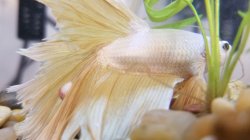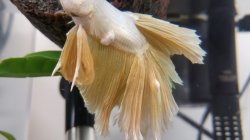CrystalTFF
New Member
- Joined
- Nov 23, 2018
- Messages
- 1
- Reaction score
- 0
I’ve tried nearly everything I can find online, and now all I can do is ask for help.
Specs:
5-gallon tank
Heated to 80 degrees
I can’t remember the name of the filter system, but it can filter up to 50 gal
Seachem Purigen filter in place of a charcoal filter
3 live plants and a little moss ball
Catappa leaves changed every few days
Water parameters as of a few minutes ago:
pH >60
Ammonia .50 ppm (This was a surprise, and I’ve already added some Seachem prime to detoxify)
Nitrite 0 ppm
Nitrate 0 ppm
Please note through all of this, Dave has never once made it look like he was sick. When I walk into the office he immediately swims to the front of the tank, he eats vigorously and swims from the top to the bottom with no issues. When I come close to the tank, there he is eyeballing me with that grumpy face. He has also had this same white coloring from the time I got him.
Story:
I got Dave about six months ago. He was fine at first, but within two weeks I noticed a small bump on his side. It almost looked like there was something under a scale. I kept an eye on it and it stayed small for about 4 months. Then there was a little bump on his tail fin. It also stayed small for about 4 months. In September everything went wrong and both bumps grew quickly and started to turn red. My water was within parameters this whole time, but I was using paper test strips so that very well could be wrong. In September the water was constantly at a high nitrite level, something I couldn’t get down no matter how many water changes. I removed some of the plants thinking I had too many and removed a little Squidward house I had in there because the edges on the inside were sharp. (I found out online that I should check them, and when I did run my finger over the inside of some of the holes I was shocked to feel how sharp they were.) So that was gone. With fewer plants, the nitrite levels were a little better but not great. This is when I started to treat him. First I did an Epsom salt bath for about five minutes, then placed him back into the tank. That didn’t help, and so I thought it might be ick, so I treated the whole tank for that. When that didn’t work I thought it might be some sort of fungal/parasite issue so I removed him from his tank and placed him into a 1-gallon medical tank with air stone and heater. There I treated him twice with Jungle fungus clear. I noticed that the bumps were no longer red and growing, but they did not reduce in size. I cleaned the entire tank, stones, filter, heater, and everything then treated it all with the fungus clear as well. (I don’t think this was necessary, but I wanted to make sure I got rid of all the fungus.) I cleaned the plants of dead leaves and waste, then soaked them a little in the fungus clear, then removed them to wait it out in a cup of distilled water. After two treatments I just placed him back into his original tank. That whole thing took about a month, and I did 50-75% water changes every week after, hoping the bumps would reduce.
Today:
Walk in and everything looks fine until I do his close up inspection and with the addition of the normal tumor-like bumps, he now seems to have a swelling in his abdomen. It is possible that this is from the ammonia spike, I believe that is also why the bump on his fin is a slight pink again. So here I am, completely at a loss on what to do next. I’ve put a lot of time, money, and energy into this guy, and I just want him to get better. So please, any ideas or direction on this issue would be so helpful.
Pictures:
I’ve included pictures of the two tumor-like bumps, and I tried to get the abdomen swelling, but it was harder to photograph. I’ve added some circles to help show what to look at.
Specs:
5-gallon tank
Heated to 80 degrees
I can’t remember the name of the filter system, but it can filter up to 50 gal
Seachem Purigen filter in place of a charcoal filter
3 live plants and a little moss ball
Catappa leaves changed every few days
Water parameters as of a few minutes ago:
pH >60
Ammonia .50 ppm (This was a surprise, and I’ve already added some Seachem prime to detoxify)
Nitrite 0 ppm
Nitrate 0 ppm
Please note through all of this, Dave has never once made it look like he was sick. When I walk into the office he immediately swims to the front of the tank, he eats vigorously and swims from the top to the bottom with no issues. When I come close to the tank, there he is eyeballing me with that grumpy face. He has also had this same white coloring from the time I got him.
Story:
I got Dave about six months ago. He was fine at first, but within two weeks I noticed a small bump on his side. It almost looked like there was something under a scale. I kept an eye on it and it stayed small for about 4 months. Then there was a little bump on his tail fin. It also stayed small for about 4 months. In September everything went wrong and both bumps grew quickly and started to turn red. My water was within parameters this whole time, but I was using paper test strips so that very well could be wrong. In September the water was constantly at a high nitrite level, something I couldn’t get down no matter how many water changes. I removed some of the plants thinking I had too many and removed a little Squidward house I had in there because the edges on the inside were sharp. (I found out online that I should check them, and when I did run my finger over the inside of some of the holes I was shocked to feel how sharp they were.) So that was gone. With fewer plants, the nitrite levels were a little better but not great. This is when I started to treat him. First I did an Epsom salt bath for about five minutes, then placed him back into the tank. That didn’t help, and so I thought it might be ick, so I treated the whole tank for that. When that didn’t work I thought it might be some sort of fungal/parasite issue so I removed him from his tank and placed him into a 1-gallon medical tank with air stone and heater. There I treated him twice with Jungle fungus clear. I noticed that the bumps were no longer red and growing, but they did not reduce in size. I cleaned the entire tank, stones, filter, heater, and everything then treated it all with the fungus clear as well. (I don’t think this was necessary, but I wanted to make sure I got rid of all the fungus.) I cleaned the plants of dead leaves and waste, then soaked them a little in the fungus clear, then removed them to wait it out in a cup of distilled water. After two treatments I just placed him back into his original tank. That whole thing took about a month, and I did 50-75% water changes every week after, hoping the bumps would reduce.
Today:
Walk in and everything looks fine until I do his close up inspection and with the addition of the normal tumor-like bumps, he now seems to have a swelling in his abdomen. It is possible that this is from the ammonia spike, I believe that is also why the bump on his fin is a slight pink again. So here I am, completely at a loss on what to do next. I’ve put a lot of time, money, and energy into this guy, and I just want him to get better. So please, any ideas or direction on this issue would be so helpful.
Pictures:
I’ve included pictures of the two tumor-like bumps, and I tried to get the abdomen swelling, but it was harder to photograph. I’ve added some circles to help show what to look at.
Attachments
-
 20181123_145746.jpg306.1 KB · Views: 107
20181123_145746.jpg306.1 KB · Views: 107 -
 20181123_145750.jpg1,016.4 KB · Views: 113
20181123_145750.jpg1,016.4 KB · Views: 113 -
 20181123_145829.jpg513.5 KB · Views: 122
20181123_145829.jpg513.5 KB · Views: 122 -
 20181123_145931.jpg290.8 KB · Views: 120
20181123_145931.jpg290.8 KB · Views: 120 -
 20181123_145937.jpg252.3 KB · Views: 111
20181123_145937.jpg252.3 KB · Views: 111 -
 20181123_153343.jpg138 KB · Views: 121
20181123_153343.jpg138 KB · Views: 121 -
 20181123_153355.jpg144.4 KB · Views: 95
20181123_153355.jpg144.4 KB · Views: 95 -
 20181123_153429.jpg456 KB · Views: 104
20181123_153429.jpg456 KB · Views: 104 -
 20181123_153453.jpg301.1 KB · Views: 102
20181123_153453.jpg301.1 KB · Views: 102

